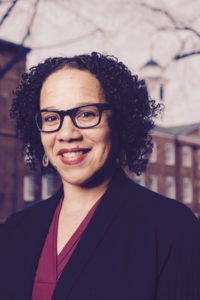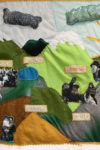Marisa J. Fuentes has written a magnificent book of an erased and silenced history. Her new work is Dispossessed Lives: Enslaved Women, Violence, and the Archive (University of Pennsylvania Press, 2016), a text Fuentes describes as probing “the constructions of race, gender, and sexuality, the machinations of archival power, and the complexities of ‘agency’ in the lives of enslaved and free(d) women in colonial Bridgetown, Barbados.” (Read an excerpt here.) Fuentes spent a decade researching Dispossessed Lives, wrestling for years with a terrible truth: The inner lives of enslaved women, Fuentes writes, are “impossible to retrieve using documents produced in a slave society limited by capitalist and elite perspectives.”
But Fuentes engaged in an ethical historical practice, restoring the lives of enslaved women in the Caribbean by drawing on literary techniques to tell the stories of a people who never were able to tell their own. In Fuentes’s book, we hear the voices of the past. And we mourn.
Andrew Mitchell Davenport: Why were your attentions drawn to Bridgetown, Barbados?
Marisa J. Fuentes: My interest in Bridgetown and Barbados dates back to my last years as an undergrad at UC Santa Cruz. I had done work in the Sea Islands of South Carolina, on issues of black landownership from the Civil War to the 1970s, and as I was reading about South Carolina’s colonial origins I discovered that British colonists from Barbados were the first to colonize the Carolinas—that there was a strong early connection in families, urban development and the enslaved people first brought into the Carolinas were from Barbados. I wanted to explore this link and pursued it into my graduate program. Dispossessed Lives draws on my graduate work which focused on enslaved women in Bridgetown and Charleston, SC. I had been really lucky that my graduate program had a summer program in Barbados for undergrads and I got to tag along for several summers as a teaching assistant. It was then, I kind of fell in love with the place and met different folks who had a strong stake in the history of the island, including archaeologists. It was Barbadian historians who suggested I focus my interest on gender and slavery on Bridgetown specifically. They were right. It proved to be a rich and devastating place to study the experiences of slavery for women and the differences between plantation and urban slavery. I spent about 2 years living there and collecting the documents that would form the foundation of the book.
As the book was taking shape I realized that my strongest connections and intellectual interests were in Barbados alone and I cut out the Charleston work for another project. Even after publishing the book, it’s something that I will continue to explore through archival and historical work.
How did conceptions of femininity—white and black—develop in Bridgetown during the colonial era?
First, I think it’s important to draw attention to the female majorities on the island. Both white and enslaved women of African descent made up the majority of the population(s)—the latter by the turn of the eighteenth-century. This was very unusual in the context of early modern colonies in the Caribbean especially when Englishmen went to the Caribbean to make quick money in sugar with the goal of going back to Europe to settle. Early on the laborers brought to Barbados were white indentured servants (including women from Ireland, Scotland and England), enslaved Africans and some Native Americans from other parts of the Caribbean and North America. When we talk about “femininity” we have to think about African, European and Indigenous women in the same society and ideas of femininity and womanhood developing in relation to each other. European perceptions of Native and African women—as barbaric, monstrous and with high tolerance for hard labor arrived in Barbados with the colonists that settled the island. While white indentured women were subject to notions of promiscuity and degrading images steeped in class prejudices many of them eventually assimilated into Barbados society after the full transition to sugar production and African slave labor. For Europeans, women of African descent remained outside of the concepts of “femininity” and womanhood because they remained (agricultural) laborers and were legally property that could be bought and sold. Racist images of African women as “beasts of burden” and hypersexual combined with their commodification further separated them from European notions of “femininity” that connoted motherhood, domesticity, fragility and virtue.

Professor Marisa J. Fuentes, author of Dispossessed Lives: Enslaved Women, Violence, and the Archive
The contradictions in these perceptions were evident in the rampant sexual exploitation of black and brown women, enslaved and free. On plantations and in urban contexts where domestic labor predominated, black and brown women were subjected to sexual violence and exploitation in their day-to-day lives. These subjugations included sexual force inflicted on them by men as well as being hired-out and sold as “prostitutes” to serve the sexual desires of itinerant men in the maritime economies that frequented Atlantic/Caribbean port towns.
The issue and reality of sexual exploitation of black and brown women fed into their alienation from the concepts of femininity and womanhood because they were used as sexual objects with (as enslaved women) no power (personal or legal) to stop the sexual exploitation and violence. These led to Europeans justifying their power to have unabated access to enslaved women with projections onto enslaved and black and brown women as licentious, predatory, and scheming. The archive is drenched in Europeans’ sexualized images of black and brown women (enslaved and free) in stark contrast to how white women were treated and expected to behave in the same society.
In Bridgetown, these issues are further complicated by the female majorities in town and where white women owned more enslaved women than other owners. While white women exploited enslaved women’s bodies (through forced prostitution and reaping wealth from enslaved women’s future children) they retained their reputations of virtue and society’s ideas of their femininity.
I should emphasize that these were ideologies that society subjected black, brown and white women to and didn’t reflect the lived realities of any group. While ideas and images of enslaved women as licentious allowed white men’s to sexually exploit and violate them with no repercussions, white women did not necessarily conform to chaste notions of femininity and virtue as evidenced in Chapter 3 of the book.
Urban slavery in the US is often referred to as being more “lenient” than in the plantation South. Your book, though its subject is urban slavery in Barbados, deconstructs this notion. How has the scholarly community responded to your research? Is there resistance to the possibility that urban slavery may have been as brutal as plantation slavery?
So far there hasn’t been resistance to my deconstruction of the violence of rural vs urban slavery—but the academic reviews aren’t out yet! I have tried to argue throughout the book that simple dichotomies belie the realities of enslaved experiences in general. Moreover, the historical work we do on these pasts should reflect the complexities and contradictions of life and power. All people in eighteenth-century slave societies lived complex lives full of contradictions. The nature of slavery as a system, where the enslaved were property and human, forced all types of contradictions onto owners and the enslaved. Another intervention here, is raising the question of how focusing on the possibilities and modes of resistance under slavery obscures the ubiquity of violence in the everyday of enslaved lives? Part of the argument historians have made about urban versus rural slavery, at least in the Caribbean, has been that enslaved people were hired out in towns, could work for themselves and had mobility that was not available to the enslaved on plantations. Of course, working in sugar was a violent and deathly production. Life expectancy for all enslaved people who produced sugar averaged from one to seven years as they were not provided adequate sustenance for the exertion required to cultivate that crop. In addition, the level of violence planters meted out to terrorize the enslaved plantation population and discourage revolts led to increased probabilities of death and disability. Enslaved women working sugar did not reproduce children in the numbers that occurred in North American plantations because the harsh working conditions severely damaged their fertility and increased infant mortality.
All that said, I wanted to point to how urban slave owners and authorities enacted violence and restricted life for urban slaves in ways that may have escaped historians’ attention. My focus on surveillance, bodily punishment, town executions, and mobile spectacles of punishment illustrate that town life for the enslaved proved just as violent. And, thinking about enslaved women in particular, their work in the domestic realm in towns made them intimately susceptible to sexualized violence from owners and the men to which they were hired out.
If there is resistance to my interventions here, they may come from historians who rely solely on statistical methods which I had argued elsewhere do more to reproduce the listings and enumerations enslaved people were subject to in archival documents than provide us with the range of experiences we should consider in slave societies.
You write of having had different intentions when you began to research in Barbados. You intended to study the lives of enslaved women, and how they built communities. What were you presented with upon arrival to the archives?
I was expecting to find fuller accounts of enslaved women in Barbados as I had read social histories which centered their lives like the works of Hillary Beckles and Jennifer Morgan. I was in Barbados, as a researcher, to compile as many documents from the archive as possible so that upon returning home I could shape a dissertation on enslaved women’s experiences as they made up the majority of the island. Instead, I was struck by the vast absence of their mentions and voices. I couldn’t find a single full story. Of course, I knew the documents would largely be written by slave owners and traders but as a student I didn’t expect to be faced with such a devastating and permanent absence of their own accounts or perspectives. They appeared in the archives as alleged criminals, enslaved prostitutes, tortured runaways, and victims of such violence that they were obscured from historical view. I ended up becoming so angry at their erasure that I focused on writing explicitly about the violence and processes of their erasure and in the process found other ways to illuminate them as individuals with their own perspectives and viewpoints even if they couldn’t “speak.” I call this an ethical historical practice which calls out historians’ claims of objectivity and scientific approaches to historical writing that demand a large empirical base from which to make generalizations. To make such demands is to ignore and normalize the violence enslaved women endured and the epistemic violence produced from an archive in which they are distorted.
Despite the enormous efforts of such a project, surely you must now think your methods of writing history from “nothing” can be replicated. How will our understanding of history shift as we grapple with a past not so easily grasped?
When thinking back through the efforts to produce this book I faced powerful moments of push-back from scholars invested in various disciplining structures. I was told that the ethical concerns of the project are not what “History” is, that I need more sources about people who left few if any, that I shouldn’t represent enslaved people as “defeated,” or implicate enslaved men in violence against enslaved women, and that the lives of the enslaved women in this book—the falsely accused executed slaves, the enslaved women who were forced to prostitute, the ones who were forcibly taken from a homeland and branded, stabbed, and stripped naked—were not remarkable compared with the poor in England in the same period.
What I’m hoping is to have challenged some of these assumptions and disciplinary/disciplining efforts to relegate these women back into historical obscurity and archival oblivion. I was purposeful in not just settling on a critique of historical methods and practice but in actually providing examples of how to narrate through power—political, historical, contemporary, archival—and offering another way of historical writing that draws on literary techniques and methods and allows us to see well-mined archival documents in new ways. There are people in all fields of history that exist in the margins (some quite literally scribbled in the margins) and I think my methods and commitments to telling marginalized or subaltern stories can be replicated in other fields (time periods, geographies etc.). Perhaps, we as scholars and writers, will be more conscious of how we reproduce systems of power, privilege, and oppression and we will work to subvert these systems in our work. It is my hope that others use my book for these purposes.
Researchers often talk about intuition, having gut feelings. I wonder if you entertain thoughts of the supernatural while you work in the archives—do you feel as if someone, someone from the past, is helping guide you? Is there an element of secular prayer involved when poring over centuries-old documents?
I think anyone working on or in the archives of slavery is dealing with the supernatural. “It’s a mortuary, a tomb,” to quote Saidiya Hartman. But perhaps not many historians will admit this? I certainly felt that my intuition guided me through the archive, especially as I was blown away at not finding what I expected. Instead, when I came upon the fragments of the women in the book, one by one, I felt strongly that they needed to be attended to—though at the time I had no idea what to say. I was pulled to certain documents. I felt this particularly with Molly’s execution and the women at the end of the book who were being whipped to death. These materials are affective, deeply painful and disturbing. I think when you’re dealing with ancestors you can be called to do certain work. During the many times when the book became too difficult—I mean the act of writing and getting it done—somehow I pushed through because, in many ways, I am the vessel through which their stories are heard. So, the work is not really about what I did but rather what work needed to be done. How can I not believe in spirits?
I think the one story that stands out is sitting alone one night, in a tiny office I rented in Berkeley to write my dissertation. I wrote the Rachael Pringle Polgreen chapter first. I had written a draft that was not as convincing as the final version because my readers wanted more evidence about Polgreen. I was frustrated with this request as I am when anyone asks for more evidence (as I mentioned above) but I turned around to look at the books I had piled around me. Thinking I would move on to something else in the meantime, I picked up a very random volume of the late 18th century abolition debates that had nothing to do with the chapter about Rachael. The volumes were in no order and my office a scene of paper and book chaos. I opened the volume in my hand and looked down at the page only to discover this was a story about Rachael beating one of her slaves. There was no way I could have found that otherwise. A coincidence? Sure. But so random I felt that I had been guided there. The same thing happened a few years later with the same chapter in the Barbados archives. I happened to be in the deed books and found the documents relating to Joanna, Rachael’s freed slave that went back to her. What is perplexing for me, on a rational plane, is that these documents were in plain sight of other historians who had worked on Rachael Polgreen. They had even cited the same pages but ignored these passages.
Ultimately, this work makes connections from this past to our present and I hope points to how the legacies of slavery still continue to haunt us in fatal ways. From mass incarceration, to police brutality, we are not disconnected from the subjects in this book and I am lucky to have been able to spend time with them and attempt to redress the injustice and violence they experienced in their lives.
Andrew Mitchell Davenport is an editor of Full Stop and The Scofield. He was recently named a Robert H. Smith Fellow at the International Center for Jefferson Studies.
This post may contain affiliate links.







